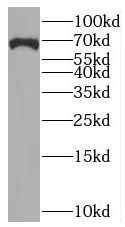Products
BRCC3 antibody
| Synonyms: | Lys-63-specific deubiquitinase BRCC36|BRCA1-A complex subunit BRCC36|BRCA1/BRCA2-containing complex subunit 3|BRCA1/BRCA2-containing complex subunit 36|BRISC complex subunit BRCC36|BRCC3|BRCC36|C6.1A|CXorf53 antibody | ||
| Catalogue No.: | FNab00945 | Reactivity: | Human, Mouse, Rat, Monkey |
| Host: | Rabbit | Tested Application: | ELISA, WB, IHC |
| Clonality: | polyclonal | Isotype: | IgG |
| Size | Price |
|---|---|
| 100µg | Inquiry |
- SPECIFICATIONS
- FIGURES
- CONDITIONS
- FAQS
- Product Name
- BRCC3 antibody
- Catalogue No.
- FNab00945
- Size
- 100μg
- Form
- liquid
- Purification
- Immunogen affinity purified
- Purity
- ≥95% as determined by SDS-PAGE
- Clonality
- polyclonal
- Isotype
- IgG
- Storage
- PBS with 0.02% sodium azide and 50% glycerol pH 7.3, -20℃ for 12 months(Avoid repeated freeze / thaw cycles.)
- Immunogen
- BRCA1/BRCA2-containing complex, subunit 3
- Alternative Names
- Lys-63-specific deubiquitinase BRCC36|BRCA1-A complex subunit BRCC36|BRCA1/BRCA2-containing complex subunit 3|BRCA1/BRCA2-containing complex subunit 36|BRISC complex subunit BRCC36|BRCC3|BRCC36|C6.1A|CXorf53 antibody
- UniProt ID
- P46736
- Observed MW
- 65-70 kDa
- Tested Applications
- ELISA, WB, IHC
- Recommended dilution
- WB: 1:500-1:2000; IHC: 1:20-1:200
 MCF7 cells were subjected to SDS PAGE followed by western blot with FNab00945(BRCC3 antibody) at dilution of 1:300
MCF7 cells were subjected to SDS PAGE followed by western blot with FNab00945(BRCC3 antibody) at dilution of 1:300
 Immunohistochemistry of paraffin-embedded human ovary using FNab00945(BRCC3 antibody) at dilution of 1:50
Immunohistochemistry of paraffin-embedded human ovary using FNab00945(BRCC3 antibody) at dilution of 1:50
- Background
- Metalloprotease that specifically cleaves 'Lys-63'-linked polyubiquitin chains(PubMed:19214193, PubMed:20656690, PubMed:24075985, PubMed:26344097). Does not have activity toward 'Lys-48'-linked polyubiquitin chains. Component of the BRCA1-A complex, a complex that specifically recognizes 'Lys-63'-linked ubiquitinated histones H2A and H2AX at DNA lesions sites, leading to target the BRCA1-BARD1 heterodimer to sites of DNA damage at double-strand breaks(DSBs). In the BRCA1-A complex, it specifically removes 'Lys-63'-linked ubiquitin on histones H2A and H2AX, antagonizing the RNF8-dependent ubiquitination at double-strand breaks(DSBs)(PubMed:20656690). Catalytic subunit of the BRISC complex, a multiprotein complex that specifically cleaves 'Lys-63'-linked ubiquitin in various substrates(PubMed:20656690, PubMed:24075985, PubMed:26344097, PubMed:26195665). Mediates the specific 'Lys-63'-specific deubiquitination associated with the COP9 signalosome complex(CSN), via the interaction of the BRISC complex with the CSN complex(PubMed:19214193). The BRISC complex is required for normal mitotic spindle assembly and microtubule attachment to kinetochores via its role in deubiquitinating NUMA1(PubMed:26195665). Plays a role in interferon signaling via its role in the deubiquitination of the interferon receptor IFNAR1; deubiquitination increases IFNAR1 activity by enhancing its stability and cell surface expression(PubMed:24075985, PubMed:26344097). Down-regulates the response to bacterial lipopolysaccharide(LPS) via its role in IFNAR1 deubiquitination(PubMed:24075985).
How many times can antibodies be recycled?
First, usually it's not suggested to recycle antibodies. After use, buffer system of antibodies has changed. The storage condition of recycled antibodies for different customers also varies. Thus, the performance efficiency of recycled antibodies can’t be guaranteed. Besides, FineTest ever conducted the antibody recycling assay. Assay results show recycling times of different antibodies also varies. Usually, higher antibody titer allows more repeated use. Customers can determine based on experimental requirements.
Notes: After incubation, we recycle rest antibodies to centrifuge tube and store at 4℃. High titer antibodies can be stored for a minimum of one week. Reuse about three times.
What are components of FineTest antibody buffer?
Components of FineTest antibody buffer are usually PBS with proclin300 or sodium azide, BSA, 50% glycerol. Common preservative is proclin300 or sodium azide, which is widely applied in the lab and industry.
How about the storage temperature and duration of FineTest antibodies?
Most antibodies are stored at -20℃. Directly-labeled flow cytometry antibodies should be stored at 2 - 8℃. The shelf life is one year. If after sales issues for purchased antibodies appear, return or replacement is available. Usually, antibodies can be still used after the one-year warranty. We can offer technical support services.
Is dilution required for FineTest antibodies? What’s the dilute solution?
Directly-labeled flow cytometry antibodies are ready-to-use without dilution. Other antibodies are usually concentrated. Follow the dilution ratio suggested in the manual. Dilute solution for different experiments also varies. Common antibody dilution buffers are acceptable(e.g. PBST, TBST, antibody blocking buffer).
How to retrieve antibodies for immunohistochemistry?
Common retrieval buffers: Tris-EDTA Buffer(pH 9.0); Citrate Buffer(pH 6.0)
Heat induced antibody retrieval:
Method 1: Water-bath heating: Put the beaker with retrieval buffer and slide in the boiling water bath. Keep the boiling state for 15min. Naturally cool to room temperature;
Method 2: Microwave retrieval: Put the beaker with retrieval buffer and slide in the microwave oven. Heat at high power for 5min, Switch OFF for 3min, Heat at medium power for 5min. Naturally cool to room temperature.
How to choose secondary antibodies?
(1) Secondary antibodies react with primary antibodies. Thus, secondary antibodies should be against host species of primary antibodies. E.g. If the primary antibody is derived from rabbit, the relevant secondary antibody should be against rabbit. E.g. goat anti rabbit or donkey anti rabbit.
(2) Choose secondary antibody conjugates according to the experimental type, e.g. ELISA, WB, IHC etc. Common enzyme conjugated secondary antibodies are labelled by HRP, AP etc. Fluorescin or dye labelled secondary antibodies are applied in immunofluorescence and flow cytometry(e.g. FITC, Cy3).
